Field Guide to the Geology of Northeast Norfolk
The Cromer Forest-bed Formation
Chalk lies under almost all of Norfolk and its top is an erosional surface. In North Norfolk a series of Early and Middle Pleistocene marine and freshwater deposits lie of this surface and are usually capped by tills and outwash sands and gravels of the Anglian glaciation (MIS 12). The marine deposits in this sandwich are known as the Wroxham Crag (formerly the Weybourne Crag) and the freshwater deposits are collective called the Cromer Forest-bed Formation (CF-bF) which was sometimes known as the Norfolk Forest-bed in the past. The name is a misnomer as there are no trees in situ but the remains of logs and stumps are often encountered and the Forest-bed name has stuck since antiquity.

The Early and Middle Pleistocene deposits are not often seen inland; only in some quarries, pits and temporary excavations. But the eroding coastline provides excellent, if intermittent, exposures that have provided large numbers of spectacular vertebrate (and other) remains for two centuries and more. From Weybourne round to Happisburgh and again at Pakefield and Corton in Suffolk the deposits are found in the lower parts of the cliffs, the sea shore and indeed off-shore too. The soft crumbling cliffs may cover up exposures with talus but during storms the exposures are refreshed and are available for study and collecting. Beware however, as the cliffs are very unstable immediately after storms and great caution should be exercised when examining the base of steep cliffs.
The Forest-bed is full of environmental evidence in the form of both sediments, structures and fossils. In it are the signals of Britain's oscillating climate that are driven by Milankovich cycles representing at least three cold stages and two warm stages. They are, in stratigraphical order:
- early Anglian cold stage (MIS 12)
- Cromerian warm stage
- Beestonian cold stage
- Pastonian warm stage
- Pre-Pastonian cold stage
Not all stages are present everywhere and exposures are very discontinuous. The division of stages into sub-stages has been made by Professor Richard West of Cambridge University on the basis of their pollen assemblages. Precise dating of deposits is difficult but they can be bracketed between around 2 million years (or more) ago for the oldest Pre-Pastonian a, up to the early Anglian less than 500,000 years ago.
Cromer Forest-bed Fossil Project

Visit this website to help to record finds from the Cromer Forest-bed
Read more
